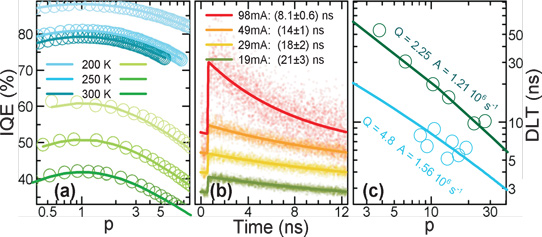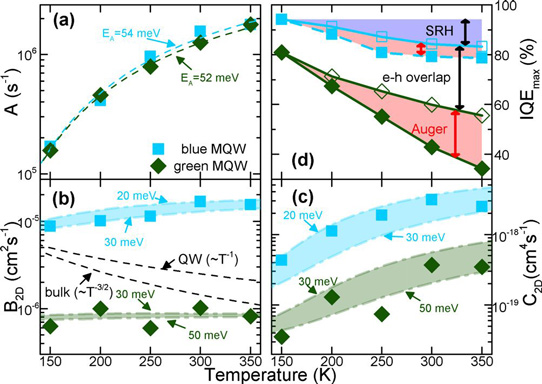- News
9 November 2016
Seeking source of green gap in indium gallium nitride light-emitting diodes
Researchers based in Germany and Russia have used temperature-dependent measurements to explore the source of the green gap in indium gallium nitride (InGaN) light-emitting diode (LED) efficiency [Felix Nippert et al, Appl. Phys. Lett., vol109, p161103, 2016].
The team from Technische Universität Berlin in Germany, STR Group–Soft-Impact Ltd in Russia, and Osram Opto Semiconductors GmbH in Germany used 'state-of-the-art' devices produced using metal-organic chemical vapor deposition (MOCVD) on c-plane sapphire and packaged using Osram's commercial Golden Dragon+ process.
Two types of LED were studied with different emission wavelengths: blue 445nm and green 530nm. "Our findings exclude inferior InGaN material quality from the list of potential causes for the green gap," the team comments.
The active regions consisted of five and seven InGaN multiple quantum wells (MQWs) for 445nm and 530nm, respectively. The barriers between the wells were GaN. The structure included an aluminium gallium nitride (AlGaN) electron-blocking layer before the magnesium-doped GaN p-contact.
The recombination was categorized according to the ABC model where the linear term in the carrier density (A) is associated with the Shockley-Read-Hall (SRH) process through defect states, the quadratic term (B) with photon production, and the cubic term (C) with Auger three-particle interactions.
The researchers used small-signal time-resolved photoluminescence (SSTRPL) to probe external quantum efficiency (EQE) and differential carrier lifetime (DLT) as a function of operating current. Determination of the DLT allowed extraction of the SRH A coefficient and of the sheet radiative, B2D, and Auger, C2D, coefficients.
The team notes that its measurements below 150K deviated from the ABC model with the internal quantum efficiency (IQE) being higher than predicted. The researchers find that below this temperature the recombination coefficients are dependent on the injection level. They therefore restricted themselves to temperatures where the ABC model held with constant coefficients.

Figure 1: (a) IQE as function of normalized optical output power (p = 1 at maximum EQE) for blue and green MQW LEDs at different temperatures. Circles correspond to data points, while solid lines are fits based on ABC model. (b) SSTRPL traces for green devices at 300K at various currents. Circles correspond to data points and solid lines show mono-exponential fits. (c) Example evaluation of SRH-RC A. Blue (green) points are measured DLTs of blue (green) MQW LED at 300K. Solid lines depict fits to data.
DLTs were found to decrease with increasing current injection (Figure 1). The IQE for the green devices was much lower than that of the blue LEDs. Also, the green IQE degraded faster with temperature.
Despite the different IQE behaviors, extracted SRH recombination was almost the same for the two device types (Figure 2). The researchers comment: "Usually, the green gap is explained by a rise in the point/structural defect density in the InGaN QWs with high indium content — an enhanced SRH recombination — or by a decreased overlap between electron and hole wavefunctions due to the [quantum-confined Stark effect] QCSE, lowering the radiative recombination. Naturally, also a combination of both factors seems plausible at first glance. In contrast, we have obtained almost identical SRH RCs A for our blue (445nm) and green (530nm) LEDs over the whole temperature range (see Fig. 2(a))."

Figure 2: Temperature dependence of RCs corresponding to (a) SRH, (b) radiative, and (c) Auger recombination. Blue squares (green diamonds) refer to blue-emitting (green-emitting) MQW LEDs. Shaded areas show theoretical estimates made for certain ranges of hole localization energy. (d) Temperature dependence of IQE. Open symbols represent values derived under assumption that B2D and C2D do not vary with temperature above 150K. Shaded areas demonstrate impact of several mechanisms to IQE reduction. Dashed lines in panel (a) and (b) show fits of activation energy EA of SRH recombination, and expected temperature dependence of B in bulk and QW material, respectively.
The difference in performance was revealed by the reduced sheet radiative and Auger recombination of the green LEDs (Figures 2(b) and (c)). There is some uncertainty due to possible differences in contribution of the quantum wells. In general, InGaN quantum well structures under electroluminescence tend to have higher emission from wells near the p-type hole-injection end as opposed to the n-contact layer.
The researchers believe that the differences in B and C recombination is attributable to reduced electron-hole overlap for the green compared with the blue devices. The radiative and Auger recombination coefficients (RCs) were also seen to increase with temperature, T. The researchers comment: "While the rise of the Auger RCs with T does not conflict qualitatively with available models considering phonon-assisted processes, a corresponding rise of the radiative RCs (blue LED) or an almost constant behaviour (green LED) is anomalous, as either a proportionality to T-3/2 (bulk materials), to T-1 (QWs), or no temperature dependence (quantum dots) is expected in semiconductors (compare with dashed lines in Fig. 2(b))."
The researchers do not think that the reduction in overlap can be explained exclusively by the quantum-confined Stark effect that arises from electric fields between increased polarization charges at quantum well interfaces, enhanced by the higher indium content of InGaN alloys needed for longer-wavelength green light emission. Rather, they propose a model where the recombination occurs between delocalized electrons and localized holes.
The localization occurs because of the higher effective mass of the holes. "We consider that a few neighboring indium atoms may provide effective carrier localization in InGaN," the researchers comment. The radiative recombination was assumed to result from hydrogen-like hole wavefunctions. Increasing temperature increases the effective localization radius, which increases the recombination. The hole localization has a similar effect on Auger recombination involving two delocalized electrons and a localized hole.
The researchers blame about half the decrease in IQE in green quantum wells at the usual LED operating temperature of 350K on decreased electron-hole overlap. Additional losses come from the temperature dependence of the radiative and Auger processes. In particular, while the radiative process is only weakly increasing with temperature, the non-radiative Auger recombination steeply increases, becoming a significant contributor to the green gap.
The team writes: "Any rise in charge carrier localization enhances the electron-phonon-coupling favoring phonon-assisted Auger processes and their impact on the IQE reduction."
http://dx.doi.org/10.1063/1.4965298
The author Mike Cooke is a freelance technology journalist who has worked in the semiconductor and advanced technology sectors since 1997.


